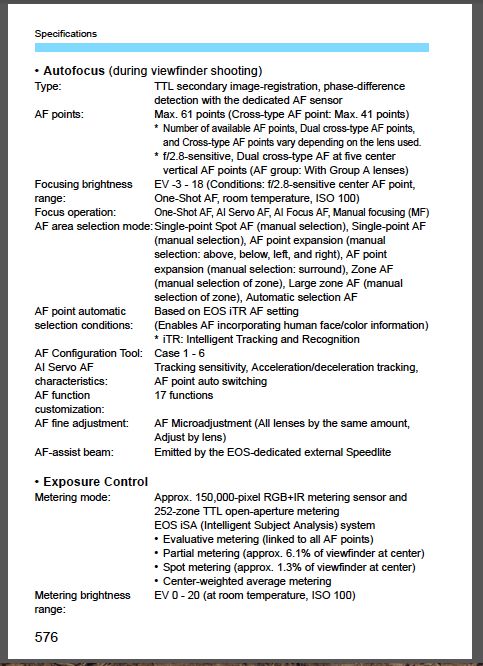+and - EV
Mar 26, 2017 17:26:11 #
I believe that the sensitivity to -3 EV is telling you how much light is needed for AF on the center AF point. The 5D MK III has a rated sensitivity to -2.5 EV. Sensitivity of -3 EV would probably AF in moonlight (full moon).
Mar 26, 2017 17:28:22 #
haroldross wrote:
I believe that the sensitivity to -3 EV is telling you how much light is needed for AF on the center AF point. The 5D MK III has a rated sensitivity to -2.5 EV. Sensitivity of -3 EV would probably AF in moonlight (full moon).
You said it better than I did!
---
Mar 26, 2017 17:39:30 #
haroldross wrote:
I believe that the sensitivity to -3 EV is telling you how much light is needed for AF on the center AF point. The 5D MK III has a rated sensitivity to -2.5 EV. Sensitivity of -3 EV would probably AF in moonlight (full moon).
Okay got it, thank you for posting this!

Mar 26, 2017 19:27:05 #
Bill_de wrote:
I think the point of the original sentence was just to say that in low light a/f will continue to work if you use the center point only, even if it fails when using multiple points.
The same is true with Nikon, although I've never seen a specific E/V.
Of course I could be wrong.
--
The same is true with Nikon, although I've never seen a specific E/V.
Of course I could be wrong.
--
No, you're right! The center points are usually cross-type sensors, which are sensitive horizontally and vertically. They can lock focus at a much lower light level than lesser focusing points. -3 EV is VERY low light. At ISO 100, that's 60 seconds at f/2.8!
Mar 27, 2017 06:06:28 #
Tracy B. wrote:
Ok, I'm reading about my Canon 5d Mark IV. I'm shooting in mostly manual. I come across this sentence and I'm confused. Here is the sentence. "The center point can function down to -3 EV for working in extremely dim lighting." My question is: If your working in dim lighting, wouldn't you be moving the EV +3? Clearly, I'm missing something.
Tracy B.:
You are not alone. I've also read things like that, that also confuse me as to + or - a Stop. And I too know what EV is. The Gossen Luna Pro and Gossen Luna Six meters I've owned look pretty much like that SmartPhone / iPhone Meter Ap BurkPhoto posted. My Minolta Spot Meter also is calibrated in EV values. It does seem like authors often do not make it clear as to whether they are taking about Exposure Values (EV) or Exposure Compensation (EC). I know what to do but sometimes the text sounds reversed.
You may have noticed that the whole discussion and use of Kelvins in White Balance (WB) is backwards. Blues light has more energy than Red light. Yet when you read about how to set your camera for different lighting conditions, say Tungsten / Quartz light to Daylight it seems to contradict quantum mechanics. It seems to be because they are talking in Photography terms about what it takes to create a balanced White Balance from where you are actually at color temperature-wise. Not sure that even makes sense since again the Kelvin scale in the camera seems backwards.




Mar 27, 2017 06:31:25 #
billnikon
Loc: Pennsylvania/Ohio/Florida/Maui/Oregon/Vermont
Tracy B. wrote:
Ok, I'm reading about my Canon 5d Mark IV. I'm shooting in mostly manual. I come across this sentence and I'm confused. Here is the sentence. "The center point can function down to -3 EV for working in extremely dim lighting." My question is: If your working in dim lighting, wouldn't you be moving the EV +3? Clearly, I'm missing something.
It all depends on the subject in the dim lighting, for a white object you might have to use -EV and for a dark one in a dim lighting you might have to use a +EV. DEPENDS. And on the plus side for a manual shooter light you this is an easy concept to understand.
Mar 27, 2017 07:40:51 #
Tracy B. wrote:
Ok, I'm reading about my Canon 5d Mark IV. I'm shooting in mostly manual. I come across this sentence and I'm confused. Here is the sentence. "The center point can function down to -3 EV for working in extremely dim lighting." My question is: If your working in dim lighting, wouldn't you be moving the EV +3? Clearly, I'm missing something.
Bad wording. I bet that's not talking about the camera setting, but the reduction in light: 3 EV less than optimal.
Mar 27, 2017 08:19:38 #
If you're shooting in manual with a fixed ISO then you leave EV at 0. If any of your three exposure settings are auto then use EV: Example would be with a dark scene you would lower the EV to give you a dark picture, thereby keeping highlights from being blown out. Of course the EV factor also may differ depending on whether your meter is spot or more average.
Mar 27, 2017 08:24:29 #
lamiaceae wrote:
Tracy B.: br br You are not alone. I've also rea... (show quote)
What is confusing or backwards about Kelvin settings? If you set the dial to the actual color temperature of the light source, it works. (Minor hue errors not counted)
Household incandescents: 2450 - 3000K
Stage/studio quartz-halogen: 3200K
Bright sun + blue sky: 5400 - 5700K
Flash: 5400 - 6000K
Fluorescent: see rating on tube or lamp base. 2700, 3500, 4100, 5000, 5500, 5600, and 6500K are all out there.
LED: see rating on box or fixture
Metal vapor (sodium or mercury): give up and override with another source!
For simpler workflow and more accurate results, just use custom white balance...
Mar 27, 2017 08:51:00 #
catchlight..
Loc: Wisconsin USA- Halden Norway
The believe the answer is based on a scale. The Canon 5DMK4 will focus down to -3.
Examples:
EV-6 Scenery away from city lights full starlight
EV-2 Light colored scenery under full moonlight
EV1 Distant buildings/skyline
EV4 Streets with street lamps – people near a bright birthday cake
EV5-EV6 Home interiors with normal lighting – bright campfire
EV8 Well-lit football or baseball stadium
EV11 People or objects in open shade on a bright day
EV14 Full moon at night with a telephoto
EV15 Subjects in high, direct or hazy sun.
EV16 Sunlit snow or bright sand
Cheers
Examples:
EV-6 Scenery away from city lights full starlight
EV-2 Light colored scenery under full moonlight
EV1 Distant buildings/skyline
EV4 Streets with street lamps – people near a bright birthday cake
EV5-EV6 Home interiors with normal lighting – bright campfire
EV8 Well-lit football or baseball stadium
EV11 People or objects in open shade on a bright day
EV14 Full moon at night with a telephoto
EV15 Subjects in high, direct or hazy sun.
EV16 Sunlit snow or bright sand
Cheers
Mar 27, 2017 09:24:39 #
They should have said that EV-3@ISO100 with a lens of specific maximum aperture like f/1.4.
Mar 27, 2017 09:52:18 #
lamiaceae wrote:
Tracy B.: br br You are not alone. I've also rea... (show quote)
Good to know I'm not the only one that reads it differently.

Mar 27, 2017 10:23:26 #
burkphoto wrote:
In photography, exposure value (EV) is a number that represents a combination of a camera's shutter speed and f-number, such that all combinations that yield the same exposure have the same EV (for any fixed scene luminance). EV normally relates directly to light level required for exposure at a given ISO.
This is a screenshot of MyLightMeter iPhone app... note the matchup of aperture and time for the current ISO and EV number.
This is a screenshot of MyLightMeter iPhone app... note the matchup of aperture and time for the current ISO and EV number.
I have that same app, and a second one, on my cellphone. I've compared them against my Minolta IVF and my Pentax spotmeter and they are in virtual agreement.
Mar 27, 2017 10:34:38 #
burkphoto wrote:
What is confusing or backwards about Kelvin settings?
What I find so confusing it when the temp increases, say from 6000K to 10000K, we say it is a 'cooler temp.' And vice-versa, from 6000K to 2500K it is 'warmer.' But, when I turn my oven on, it is pre-set to 350F and when I adjust it to 450F it is 'warmer' in the oven and vice-versa from 350F to 200F is 'cooler.'
Mar 27, 2017 10:34:49 #
BebuLamar wrote:
They should have said that EV-3@ISO100 with a lens of specific maximum aperture like f/1.4.
They stated on page 576, the conditions; f/2.8, One shot AF, Room temperature, and ISO 100.
If you want to reply, then register here. Registration is free and your account is created instantly, so you can post right away.







